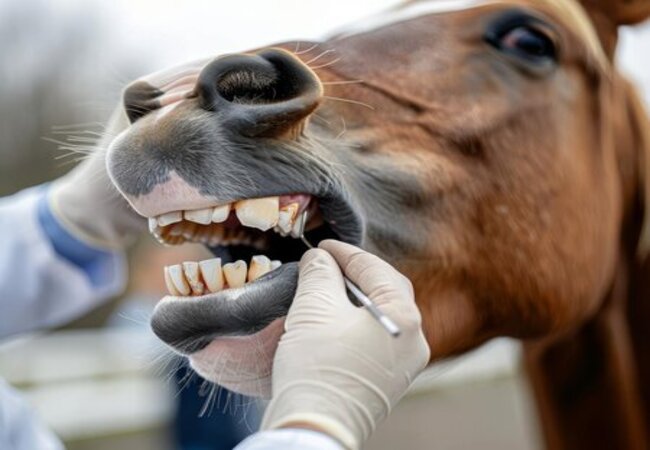Horse Teeth Floating 2025: Veterinary Guide 🩺🐾

In this article
Horse Teeth Floating 2025: Veterinary Guide 🩺🐾
By Dr. Duncan Houston BVSc
I’m Dr Duncan Houston BVSc, veterinarian and founder of Ask A Vet. Horses' hypsodont teeth continuously erupt but don’t always wear evenly, creating sharp points, hooks, waves, and malocclusions. These can cause pain, poor chewing, weight loss, or performance issues. In this comprehensive 2025 guide, I’ll cover why dental floating is essential, how and when it's done, sedation considerations, risks, costs, and aftercare — plus how Ask A Vet helps streamline care. Let’s ensure your horse chews happily and stays healthy! 🐴💙
1. 🦷 Why Floating Matters
- Shapes uneven wear—balances grinding surfaces 🎯
- Reduces sharp enamel points, hooks, ramps, and waves—prevents ulcers and painful chewing
- Boosts bite comfort, digestion, feed efficiency, manure quality
- Maintains performance—less bit resistance, head toss
- Prevents tooth fractures, infections, periodontal disease, and choke
2. 🧬 Horses’ Dental Anatomy & Malocclusions
Equine teeth erupt throughout their entire life, but a mismatch between the upper and lower jaws causes uneven wear. Types of malocclusion:
- Points: Upper teeth outer edges, inner edges of lower
- Hooks: First or last molars create chewing inefficiencies
- Waves/Steps: Varying heights across arcades—impede lateral chewing
These issues can lead to jaw strain, TMJ soreness, poor feed utilization, and behavioral changes.
3. 🔎 Diagnosis & Dental Exam
- Observe feed dropping, salivation, head-tilt, weight loss, bit resistance, facial swelling, or nasal discharge
- Oral exam using speculum and bright light; possibly endoscope
- Palpation of TMJ & monitoring bite motion
- Evaluate overall health—bodyweight, gym signs to rule out systemic disease
4. 🛠️ How Floating is Performed
- Mild sedation (e.g., xylazine, butorphanol) improves safety and compliance
- Place halter/hock, fit speculum to hold mouth open
- Use a manual rasp or power float (air or battery tool) to reshape teeth gradually
- Rinse your mouth to remove debris and cool enamel to prevent overheating
- Assess balance, smoothness, and symmetry
Floating should be conservative—over-filing can damage enamel and expose pulp, leading to issues.
5. 🧪 Sedation & Safety Considerations
- Most horses are sedated; sedation ensures safety for the horse and the handler
- Fast food 30–60 minutes before? Not required, but clearing the feed can ease flushing
- Monitor sedation effects—don’t ride or drive horses within 24 hours
- TMJ soreness may follow floating—monitor and adjust the next schedule if needed
6. 📅 How Often Should You Float?
| Age / Stage | Recommended Frequency |
|---|---|
| Foals/yearlings (1–2 yrs) | Check periodically; first float ~18–24 mo |
| Young adults (2–5 yrs) | Every 6 months |
| Adults (6–17 yrs) | Annually |
| Seniors (17+ yrs) | Annual, with possible issues—monitor condition |
7. 💵 Cost of Floating
Typically ranges from $200–$300, with sedation included. Costs vary by region, sedation needs, exam complexity, and duration (30–60+ min). Ask your vet for accurate rates.
8. 📋 Aftercare & Riding Recommendations
- Allow 24 hrs recovery before riding or heavy work
- Monitor for jaw soreness, feed intake, and bite comfort
- Keep fresh water and soft forage available initially
- Recheck during the next routine exam or earlier if issues arise
9. ⚠️ Risks & What to Watch For
- Over-filing: weak enamel, thermal injury, pulp exposure
- Sedation reactions—rare but possible
- TMJ or muscle stiffness—use gentle jaw exercises
- Missed abscesses or root diseases—ensure thorough oral exam
10. ✅ Choose a Qualified Professional
- Equine vets are trained; some hold dental specialty certifications
- Equine dental technicians may perform floats depending on the jurisdiction
- Ensure proper training and tools—incorrect floating can do more harm than good
11. 🧩 Tools & Support: Ask A Vet
- Ask A Vet: Telehealth consults for pre-float advice, post-exam follow-up, and sedation management
12. 📝 Final Thoughts
Floating is a cornerstone of equine health and comfort. By routinely smoothing sharp tooth edges, you support better chewing, digestion, performance, and lifespan. In 2025, with refined sedation and precision tools, professional dental floats are safer and more effective than ever. Partner with a qualified vet or certified technician, follow recommended schedules, and leverage Ask A Vet to streamline care. Healthy teeth = happy horses! 🐴💙






